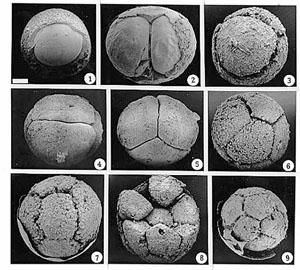
© Associated Press
A team of scientists announced Wednesday they have discovered a rare 600-million-year old microscopic fossil, raising the possibility that the theory of cell evolution may face a major overhaul.
The fossil, which researchers are saying could force scientists to rethink the evolutionary process, is a remarkable new fossil discovery of an amoeba-like micro-organisms that lived 570 million years ago.
The team of scientists announced the discovery on Wednesday, saying the recent dig was surprising as it was rare.
"We were very surprised by our results - we've been convinced for so long that these fossils represented the embryos of the earliest animals - much of what has been written about the fossils for the last ten years is flat wrong. Our colleagues are not going to like the result," said Dr. Phillip Donoghue, professor at University of Bristol, and a lead author of the article.
The fossil discovery is likely to present challenges for scientists in explaining how early complex life emerged on the planet. It remains unclear what role the micro-organisms played in the prehistoric world, however, scientists noted that the discovery revealed that the fossilized remains were neither animal nor embryos. The team noted that the fossilized remains were perhaps a predecessor to the last common ancestor of animals.
The fossils preserve stages in the life cycle of an amoeba-like organism dividing in asexual cycles, first to produce two cells, then four, eight and so on, ultimately resulting in hundreds of thousands of spore-like cells that were then released to start the cycle over again.
The pattern of cell division is so similar to the early stages of animal, including human, embryology that until now they were thought to represent the embryos of the earliest animals.
The rocks, which contained the fossils, were discovered in the Doushantuo rock formation in southern China. Scientists say the micro-organisms lived during the Ediacaran geologic period. The formation is located in Guizhou Province, China, and is notable for being one of the oldest fossil beds to contain highly preserved fossils. The formation is of particular interest because it appears to cover the boundary between the problematic organisms of the Ediacaran geological period and the more familiar fauna of the Cambrian explosion of lifeforms whose descendants are recognizable.
The researchers studied the microscopic fossils using high energy X-rays at the Swiss Light Source in Switzerland, revealing the organisation of the cells within their protective cyst walls. Scientists said the process could shed light on how human cell development evolved over the course of hundreds of millions of years.
By tracing the evidence of the cell growth in the fossils, the team found that the fossils did not develop new tissue types the way animals would. The cells kept dividing through palintomy, creating more tiny cells that eventually lost their shape and got squeezed out as if being released as spores.
The condition of the Doushantuo fossils is exceptional. In some of the samples, "even their nuclei have been preserved," said Therese Huldtgren, of the Swedish Museum of Natural history and co-author.
The new study is published in the journal,
Science.
Source: The State Column
[Link]